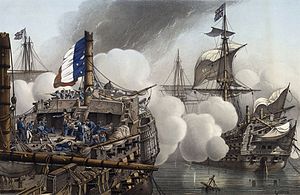 Tonnant at the Battle of the Nile, by Louis Lebreton.
| |
| History | |
|---|---|
| Name | Tonnant |
| Laid down | November 1787 |
| Launched | 12 October 1789 |
| Completed | September 1790 |
| Honours and awards |
|
| Captured | By the Royal Navy on 2 August 1798 |
| Name | HMS Tonnant |
| Acquired | Captured on 2 August 1798 |
| Honours and awards |
|
| Fate | Broken up in March 1821 |
| General characteristics [1] [2] | |
| Class and type | 80-gun Tonnant-class ship of the line |
| Tons burthen | 22813⁄94 (bm) |
| Length | |
| Beam | 51 ft 9+1⁄4 in (15.8 m) |
| Depth of hold | 23 ft 3 in (7.1 m) |
| Sail plan | Full-rigged ship |
| Complement | 700 |
| Armament |
|
HMS Tonnant (lit. 'Thundering') was an 80-gun ship of the line of the Royal Navy. She had previously been Tonnant of the French Navy and the lead ship of the Tonnant class. The British captured her in August 1793 during the Siege of Toulon but the French recaptured her when the siege was broken in December. Rear-Admiral Horatio Nelson captured her at Aboukir Bay off the coast of Egypt at the Battle of the Nile on 1 August 1798. She was taken into British service as HMS Tonnant. She went on to fight at the Battle of Trafalgar in 1805, during the Napoleonic Wars.
Tonnant became the flagship of Vice-Admiral Sir Alexander Cochrane when he assumed command of the North American Station in March of 1814 during the War of 1812 with the United States. On 7 September 1814 Francis Scott Key and John Stuart Skinner dined aboard the ship while seeking the release of a captured civilian prisoner, several days before the Battle of Baltimore. Key went on to write what later became the words to the American national anthem, "The Star-Spangled Banner" after watching the British attack on Baltimore's Fort McHenry. Tonnant was broken up in 1821.
- ^ Winfield & Roberts (2015), p. 57.
- ^ Winfield (2008), p. 33.